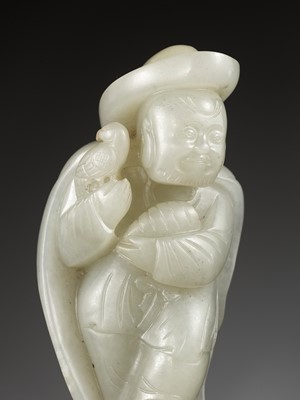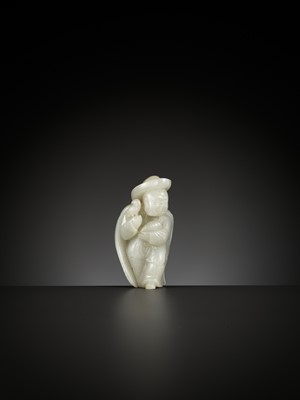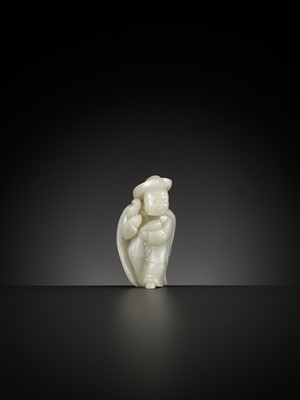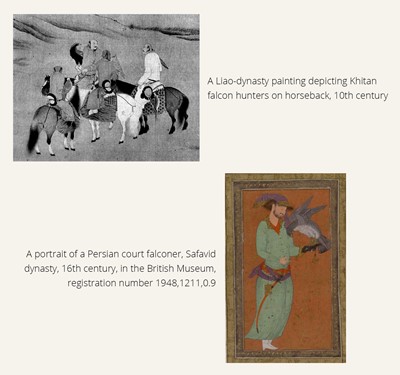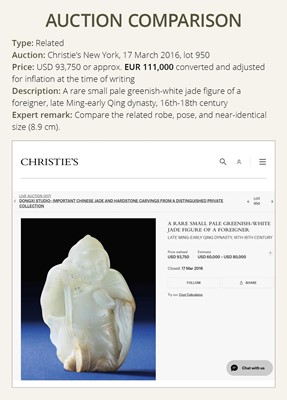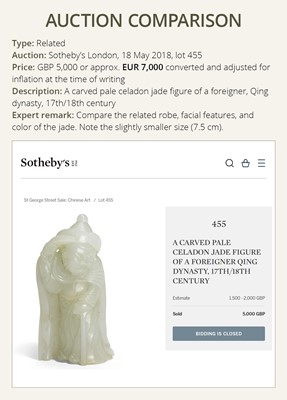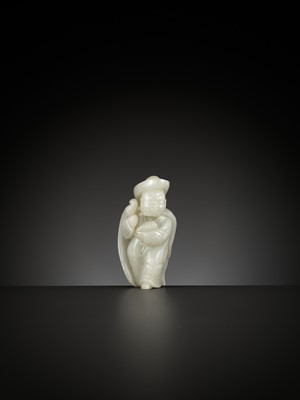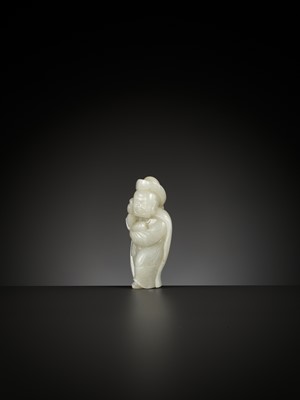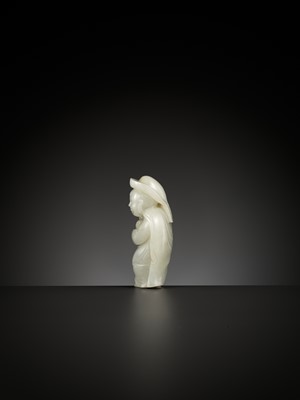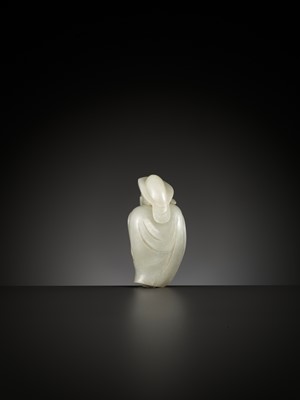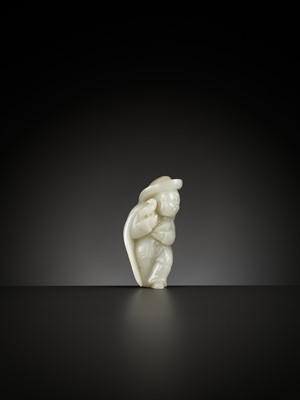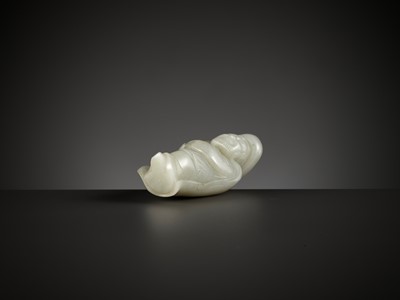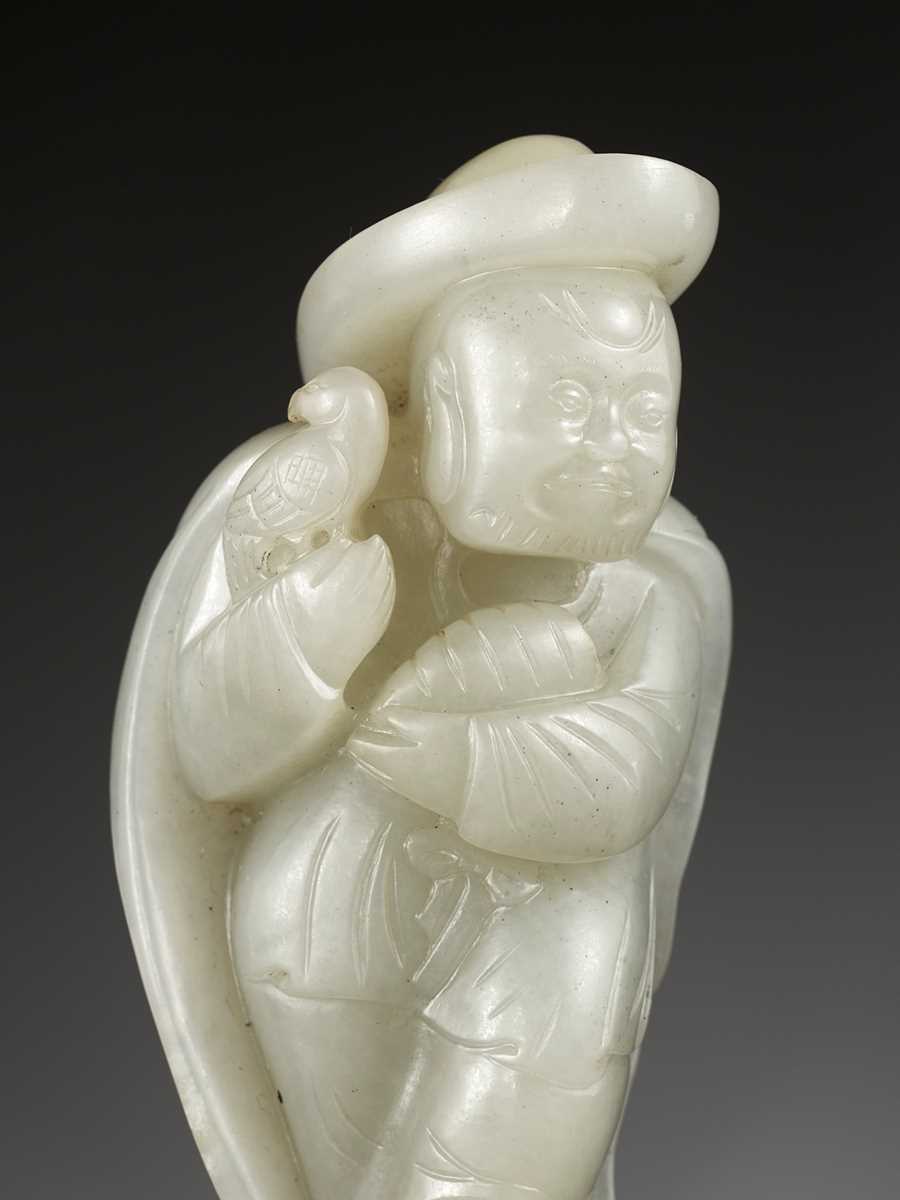9th Mar, 2023 13:00
TWO-DAY AUCTION - Fine Chinese Art / 中國藝術集珍 / Buddhism & Hinduism
44
A PALE CELADON JADE FIGURE OF A PERSIAN FALCONER, 18TH CENTURY
十八世紀青白玉波斯馴鷹人
Sold for €4,160
including Buyer's Premium
China. Finely carved, clad in a long cloak hanging over the shoulders and loose robes tied at the waist, wearing a large hat, a falcon perched on his right hand, and holding a treasure in his left hand, his square face with a broad mouth and short beard, flanked by elongated earlobes. The finely polished stone of translucent quality showing an even, pale celadon color with only scattered cloudy-white inclusions.
Provenance: British trade.
Condition: Very good condition with expected old wear and few minuscule nicks to the rim of the hat. Good, unctuous feel overall.
Weight: 143.4 g
Dimensions: Height 8.4 cm
The costume of this well-carved figure identifies him as a foreigner, while the treasure held in his hand suggests he is a tribute bearer. The falcon in his right hand also indicates that he is a falconer, most likely of Persian descent. Small jade figures of this type were first made during the Tang dynasty when figures of foreigners were produced in various materials, representing the cosmopolitan society of the period.
Falcons and falconry have been part of the religious and ideological tradition of the Persianate world from remote antiquity to the pre-modern period. The falcon has been important as a symbol of royal ideology and political legitimation. Already from the earliest Zoroastrian hymns, the Avesta, to manuals on falconry in the nineteenth century, the importance of this bird and the sport is detailed. As the privileged hobby of sovereigns and high dignitaries, falconry seems to have flourished in pre-Islamic Iran, as evidenced by various legends relating to hunting parties. In Islamic Iran, the expensive sport of hunting with falcons continued to be a favorite entertainment of the rulers and high dignitaries, enabling them to parade military prowess in times of peace. The prestige of such sport was enhanced because the Arab overlords in Baghdad and their provincial deputies, after having encountering the Persians, Byzantines, and others, had developed a keen enthusiasm for falconry.
Auction result comparison:
Type: Related
Auction: Sotheby’s London, 18 May 2018, lot 455
Price: GBP 5,000 or approx. EUR 7,000 converted and adjusted for inflation at the time of writing
Description: A carved pale celadon jade figure of a foreigner, Qing dynasty, 17th/18th century
Expert remark: Compare the related robe, facial features, and color of the jade. Note the slightly smaller size (7.5 cm).
Auction result comparison:
Type: Related
Auction: Christie’s New York, 17 March 2016, lot 950
Price: USD 93,750 or approx. EUR 111,000 converted and adjusted for inflation at the time of writing
Description: A rare small pale greenish-white jade figure of a foreigner, late Ming-early Qing dynasty, 16th-18th century
Expert remark: Compare the related robe, pose, and near-identical size (8.9 cm).
十八世紀青白玉波斯馴鷹人
中國,人物身披長氅,寬袍束腰,頭戴暖帽,右手上停著一隻鷹,左手執寶,方臉闊口短鬚。表面拋光細膩,玉料成均匀的半透明青色,白色絮狀物。
來源:英國古玩交易
品相:品相極好,磨損,帽子邊緣有細小的劃痕。整體包漿瑩潤。
重量:143.4 克
尺寸:高8.4 厘米
這個雕刻精美的人物的服裝表明他是外國人,而他手中拿著的寶物表明他是貢品。他右手的獵鷹也表明他是一名馴鷹者,很可能是波斯血統。這種小玉人最早出現在唐代,當時用各種材料製作外國人的形象,代表了那個時期的國際化社會。
從遠古到近現代時期,獵鷹和馴服獵鷹一直是波斯世界宗教和意識形態傳統的一部分。獵鷹是重要的皇家意識形態和政治合法性的象徵。從最早的瑣羅亞斯德的讚美詩阿維斯塔,到 19 世紀的獵鷹手冊,都詳細介紹馴服獵鷹的重要性。馴服獵鷹似乎盛行於伊斯蘭時代以前的伊朗,也是君主和達官貴人的特權和愛好,有許多關於狩獵派對的各種傳說。在伊斯蘭化後的伊朗,以獵鷹舉行昂貴的狩獵運動仍然是統治者和達官貴人最喜歡的娛樂活動,用來在和平時期炫耀其軍事實力。 由於巴格達的阿拉伯霸主及其省級代表在與波斯人、拜占庭人和其他國家接觸後,對馴服獵鷹產生了濃厚的興趣,因此提高了這項運動的聲望。
拍賣結果比較:
形制:相近
拍賣:倫敦蘇富比,2018年5月18日,lot 455
價格:GBP 5,000(相當於今日EUR 7,000)
描述:清十七/十八世紀青白玉雕胡人
專家評論:比較相近的長袍、面部特徵和玉石顏色。請注意尺寸 (7.5 厘米)較小。
拍賣結果比較:
形制:相近
拍賣:紐約佳士得,2016年3月17日,lot 950
價格:USD 93,750(相當於今日EUR 111,000)
描述:明末/清十八世紀青白玉胡人像
專家評論:比較相近的長袍、姿勢和幾乎相同的尺寸 (8.9 厘米)。
China. Finely carved, clad in a long cloak hanging over the shoulders and loose robes tied at the waist, wearing a large hat, a falcon perched on his right hand, and holding a treasure in his left hand, his square face with a broad mouth and short beard, flanked by elongated earlobes. The finely polished stone of translucent quality showing an even, pale celadon color with only scattered cloudy-white inclusions.
Provenance: British trade.
Condition: Very good condition with expected old wear and few minuscule nicks to the rim of the hat. Good, unctuous feel overall.
Weight: 143.4 g
Dimensions: Height 8.4 cm
The costume of this well-carved figure identifies him as a foreigner, while the treasure held in his hand suggests he is a tribute bearer. The falcon in his right hand also indicates that he is a falconer, most likely of Persian descent. Small jade figures of this type were first made during the Tang dynasty when figures of foreigners were produced in various materials, representing the cosmopolitan society of the period.
Falcons and falconry have been part of the religious and ideological tradition of the Persianate world from remote antiquity to the pre-modern period. The falcon has been important as a symbol of royal ideology and political legitimation. Already from the earliest Zoroastrian hymns, the Avesta, to manuals on falconry in the nineteenth century, the importance of this bird and the sport is detailed. As the privileged hobby of sovereigns and high dignitaries, falconry seems to have flourished in pre-Islamic Iran, as evidenced by various legends relating to hunting parties. In Islamic Iran, the expensive sport of hunting with falcons continued to be a favorite entertainment of the rulers and high dignitaries, enabling them to parade military prowess in times of peace. The prestige of such sport was enhanced because the Arab overlords in Baghdad and their provincial deputies, after having encountering the Persians, Byzantines, and others, had developed a keen enthusiasm for falconry.
Auction result comparison:
Type: Related
Auction: Sotheby’s London, 18 May 2018, lot 455
Price: GBP 5,000 or approx. EUR 7,000 converted and adjusted for inflation at the time of writing
Description: A carved pale celadon jade figure of a foreigner, Qing dynasty, 17th/18th century
Expert remark: Compare the related robe, facial features, and color of the jade. Note the slightly smaller size (7.5 cm).
Auction result comparison:
Type: Related
Auction: Christie’s New York, 17 March 2016, lot 950
Price: USD 93,750 or approx. EUR 111,000 converted and adjusted for inflation at the time of writing
Description: A rare small pale greenish-white jade figure of a foreigner, late Ming-early Qing dynasty, 16th-18th century
Expert remark: Compare the related robe, pose, and near-identical size (8.9 cm).
十八世紀青白玉波斯馴鷹人
中國,人物身披長氅,寬袍束腰,頭戴暖帽,右手上停著一隻鷹,左手執寶,方臉闊口短鬚。表面拋光細膩,玉料成均匀的半透明青色,白色絮狀物。
來源:英國古玩交易
品相:品相極好,磨損,帽子邊緣有細小的劃痕。整體包漿瑩潤。
重量:143.4 克
尺寸:高8.4 厘米
這個雕刻精美的人物的服裝表明他是外國人,而他手中拿著的寶物表明他是貢品。他右手的獵鷹也表明他是一名馴鷹者,很可能是波斯血統。這種小玉人最早出現在唐代,當時用各種材料製作外國人的形象,代表了那個時期的國際化社會。
從遠古到近現代時期,獵鷹和馴服獵鷹一直是波斯世界宗教和意識形態傳統的一部分。獵鷹是重要的皇家意識形態和政治合法性的象徵。從最早的瑣羅亞斯德的讚美詩阿維斯塔,到 19 世紀的獵鷹手冊,都詳細介紹馴服獵鷹的重要性。馴服獵鷹似乎盛行於伊斯蘭時代以前的伊朗,也是君主和達官貴人的特權和愛好,有許多關於狩獵派對的各種傳說。在伊斯蘭化後的伊朗,以獵鷹舉行昂貴的狩獵運動仍然是統治者和達官貴人最喜歡的娛樂活動,用來在和平時期炫耀其軍事實力。 由於巴格達的阿拉伯霸主及其省級代表在與波斯人、拜占庭人和其他國家接觸後,對馴服獵鷹產生了濃厚的興趣,因此提高了這項運動的聲望。
拍賣結果比較:
形制:相近
拍賣:倫敦蘇富比,2018年5月18日,lot 455
價格:GBP 5,000(相當於今日EUR 7,000)
描述:清十七/十八世紀青白玉雕胡人
專家評論:比較相近的長袍、面部特徵和玉石顏色。請注意尺寸 (7.5 厘米)較小。
拍賣結果比較:
形制:相近
拍賣:紐約佳士得,2016年3月17日,lot 950
價格:USD 93,750(相當於今日EUR 111,000)
描述:明末/清十八世紀青白玉胡人像
專家評論:比較相近的長袍、姿勢和幾乎相同的尺寸 (8.9 厘米)。
Zacke Live Online Bidding
Our online bidding platform makes it easier than ever to bid in our auctions! When you bid through our website, you can take advantage of our premium buyer's terms without incurring any additional online bidding surcharges.
To bid live online, you'll need to create an online account. Once your account is created and your identity is verified, you can register to bid in an auction up to 12 hours before the auction begins.
Intended Spend and Bid Limits
When you register to bid in an online auction, you will need to share your intended maximum spending budget for the auction. We will then review your intended spend and set a bid limit for you. Once you have pre-registered for a live online auction, you can see your intended spend and bid limit by going to 'Account Settings' and clicking on 'Live Bidding Registrations'.
Your bid limit will be the maximum amount you can bid during the auction. Your bid limit is for the hammer price and is not affected by the buyer’s premium and VAT. For example, if you have a bid limit of €1,000 and place two winning bids for €300 and €200, then you will only be able to bid €500 for the rest of the auction. If you try to place a bid that is higher than €500, you will not be able to do so.
Online Absentee and Telephone Bids
You can now leave absentee and telephone bids on our website!
Absentee Bidding
Once you've created an account and your identity is verified, you can leave your absentee bid directly on the lot page. We will contact you when your bids have been confirmed.
Telephone Bidding
Once you've created an account and your identity is verified, you can leave telephone bids online. We will contact you when your bids have been confirmed.
Classic Absentee and Telephone Bidding Form
You can still submit absentee and telephone bids by email or fax if you prefer. Simply fill out the Absentee Bidding/Telephone bidding form and return it to us by email at office@zacke.at or by fax at +43 (1) 532 04 52 20. You can download the PDF from our Upcoming Auctions page.
How-To Guides
How to Create Your Personal Zacke Account
How to Register to Bid on Zacke Live
How to Leave Absentee Bids Online
How to Leave Telephone Bids Online
中文版本的操作指南
创建新账号
注册Zacke Live在线直播竞拍(免平台费)
缺席投标和电话投标
Third-Party Bidding
We partner with best-in-class third-party partners to make it easy for you to bid online in the channel of your choice. Please note that if you bid with one of our third-party online partners, then there will be a live bidding surcharge on top of your final purchase price. You can find all of our fees here. Here's a full list of our third-party partners:
- 51 Bid Live
- EpaiLive
- ArtFoxLive
- Invaluable
- LiveAuctioneers
- the-saleroom
- lot-tissimo
- Drouot
Please note that we place different auctions on different platforms. For example, in general, we only place Chinese art auctions on 51 Bid Live.
Bidding in Person
You must register to bid in person and will be assigned a paddle at the auction. Please contact us at office@zacke.at or +43 (1) 532 04 52 for the latest local health and safety guidelines.
